Discharge Plasma Treatment as an Efficient Tool for Improved Poly(lactide) Adhesive–Wood Interactions
Abstract
1. Introduction
2. Materials and Methods
2.1. PLA Film Preparation
2.2. Barrier Discharge Plasma Wood Treatment
2.3. Fourier-Transform Infrared Spectroscopy (FTIR)
2.4. X-Ray Photoelectron Spectroscopy (XPS)
2.5. Oak Wood Bonding and Shear Strength Testing
2.6. Pull-Off Testing
2.7. Contact Angle Measurements and Surface Free Energy (SFE) Calculations
2.8. SEM Analysis
3. Results and Discussion
3.1. Chemical and Physical Changes in PLA Surface
3.1.1. X-ray Photoelectron Spectroscopy
3.1.2. SEM Analysis
3.1.3. Fourier-Transform Infrared Spectroscopy
3.2. Contact Angle and Surface Free Energy (SFE)
3.3. Effect of Plasma Treatment on the Performance of Adhesive Joints
4. Conclusions
Supplementary Materials
Author Contributions
Funding
Institutional Review Board Statement
Informed Consent Statement
Data Availability Statement
Conflicts of Interest
References
- Statlista. Available online: https://www.statista.com/statistics/964392/mar-ket-value-polylactic-acid-worldwide (accessed on 11 June 2021).
- Mamiński, M.Ł.; Toczyłowska-Mamińska, R. Bio-derived adhesives and matrix polymers for composites. In Handbook of Composites from Renewable Materials, 1st ed.; Thakur, V.K., Thakur, M.K., Kessler, M.R., Eds.; Wiley: Hoboken, NJ, USA, 2017; Volume 1, pp. 151–188. [Google Scholar]
- Montava-Jordà, S.; Quiles-Carrillo, L.; Richart, N.; Torres-Giner, S.; Montanes, N. Enhanced interfacial adhesion of polylactide/poly(ε-caprolactone)/walnut shell flour composites by reactive extrusion with maleinized linseed oil. Polymers 2019, 11, 758. [Google Scholar] [CrossRef]
- Viljanmaa, M.; Södergård, A.; Törmälä, P. Lactic acid based polymers as hot melt adhesives for packaging applications. Int. J. Adhes. Adhes. 2002, 22, 219–226. [Google Scholar] [CrossRef]
- Castro-Aguirre, E.; Iñiguez-Franco, F.; Samsudin, H.; Fang, X.; Auras, R. Poly(lactic acid)—Mass production, processing, industrial applications, and end of life. Adv. Drug Deliv. Rev. 2016, 107, 333–366. [Google Scholar] [CrossRef] [PubMed]
- Malkappa, K.; Bandyopadhyay, J.; Sinha Ray, S. Thermal degradation characteristic and flame retardancy of polylactide-based nanobiocomposites. Molecules 2018, 23, 2648. [Google Scholar] [CrossRef]
- Vainionpaa, S.; Rokkanen, P.; Törmälä, P. Surgical applications of biodegradable polymers in human tissues. Prog. Polym. Sci. 1989, 14, 679–716. [Google Scholar] [CrossRef]
- Semba, T.; Kitagawa, K.; Ishiaku, U.S.; Hamada, H. The effect of crosslinking on the mechanical properties of polylactic acid/polycaprolactone blends. J. Appl. Polym. Sci. 2006, 101, 1816–1825. [Google Scholar] [CrossRef]
- Lähteenkorva, K.; Törmälä, P. Drying and melt processing conditions of PLA. In Proceedings of the Second Symposium on: Frontiers in Biomedical Polymers. Biomaterials and Drug Delivery Systems, Eilat, Israel, 6–9 April 1997; p. 25. [Google Scholar]
- Södergård, A.; Näsman, J.H. Stabilization of poly(l-lactide) in the melt. Polym. Degrad. Stabil. 1994, 46, 25–30. [Google Scholar] [CrossRef]
- Eom, Y.; Bulim, C.; Park, C.-S. A study on mechanical and thermal properties of PLA/PEO blends. J. Polym. Environ. 2019, 27, 256–262. [Google Scholar] [CrossRef]
- Viljanmaa, M.; Södergård, A.; Törmälä, P. The use of lactic acid-based hot melt adhesive in the industrial lamination process. Int. J. Adhes. Adhes. 2003, 23, 151–154. [Google Scholar] [CrossRef]
- Leibfarth, F.A.; Moreno, N.; Hawker, A.P.; Shand, J.D. Transforming polylactide into value-added materials. J. Polym. Sci. Pol. Chem. 2012, 50, 4814–4822. [Google Scholar] [CrossRef]
- Faludi, G.; Renner, D.K.; Móczó, J.; Pukánszky, B. Improving interfacial adhesion in PLA/wood biocomposites. Compos. Sci. Technol. 2013, 89, 77–82. [Google Scholar] [CrossRef]
- Sang, L.; Han, S.; Li, Z.; Yang, X.; Hou, W. Development of short basalt fiber reinforced polylactide composites and their feasible evaluation for 3D printing applications. Compos. Part B Eng. 2019, 164, 629–639. [Google Scholar] [CrossRef]
- Schiavone, N.; Verney, V.; Askanian, H. Pozzolan based 3D printing composites: From the formulation till the final application in the precision irrigation field. Materials 2021, 14, 43. [Google Scholar] [CrossRef] [PubMed]
- Liu, X.; Wang, T.; Chow, L.C.; Yang, M.; Mitchell, J.W. Effects of inorganic fillers on the thermal and mechanical properties of poly(lactic acid). Int. J. Polym. Sci. 2014, 2014, 827028. [Google Scholar] [CrossRef]
- Hu, H.; Xu, A.; Zhang, D.; Zhou, W.; Peng, S.; Zhao, X. High-toughness poly(lactic acid)/starch blends prepared through Reactive Blending Plasticization and Compatibilization. Molecules 2020, 25, 5951. [Google Scholar] [CrossRef]
- Liston, E.M.; Martinu, L.; Wertheimer, M.R. Plasma surface modification of polymers for improved adhesion: A critical review. J. Adhes. Sci. Technol. 1993, 7, 1091–1127. [Google Scholar] [CrossRef]
- Xiao-rui, P.; Zhan-kuan, Z. Improvement of paint adhesion of environmentally friendly paint film on wood surface by plasma treatment. Prog. Org. Coat. 2019, 134, 255–263. [Google Scholar]
- Sauerbier, P.; Köhler, R.; Renner, G.; Militz, H. Surface activation of polylactic acid-based wood-plastic composite by atmospheric pressure plasma treatment. Materials 2020, 13, 4673. [Google Scholar] [CrossRef]
- Antunes, A.; Luyt, A.S.; Kasak, P.; Aljarod, O.; Hassan, M.K.; Popelka, A. Effect of plasma treatment on accelerated PLA degradation. Express Polym. Lett. 2021, 15, 725–774. [Google Scholar] [CrossRef]
- SulzerChemtech. Available online: https://www.sulzer.com/-/media/files/products/polymer_production_technology/brochures/fact_sheet_polylactides.ashx (accessed on 20 April 2021).
- Al Maadeed, M.A.; Nogellova, Z.; Mičušík, M.; Novak, I.; Krupa, I. Mechanical, sorption and adhesive properties of composites based on low-density polyethylene filled with date palm wood powder. Mater. Des. 2014, 53, 29–37. [Google Scholar] [CrossRef]
- Wolkenhauer, A.; Avramidis, G.; Hauswald, E.; Militz, H.; Viöl, W. Sanding vs. plasma pretreatment of aged wood: A comparison with respect to surface energy. Int. J. Adhes. Adhes. 2009, 29, 18–22. [Google Scholar] [CrossRef]
- Izdebska-Podsiadły, J.; Dörsam, E. Storage stability of the oxygen plasma-modified PLA film. Bull. Mater. Sci. 2021, 44, 79–87. [Google Scholar] [CrossRef]
- Šunka, P.; Babický, V.; Člupek, M.; Lukeš, P.; Šimek, M.; Schmidt, J.; Černák, M. Generation of chemically active species by electrical discharges in water. Plasma Sources Sci. Technol. 1999, 8, 258–265. [Google Scholar] [CrossRef]
- Novák, I.; Sedliačik, J.; Gajtanska, M.; Schidtová, J.; Popelka, A.; Bekhta, P.; Krystofiak, T.; Proszyk, S.; Žigo, O. Effect of barrier plasma pre-treatment on polyester films and their adhesive properties on oak wood. Bioresources 2016, 11, 6335–6345. [Google Scholar] [CrossRef]
- Latos-Brozio, M.; Masek, A. The application of (+)-catechin and polydatin as functional additives for biodegradable polyesters. Int. J. Mol. Sci. 2020, 21, 414. [Google Scholar] [CrossRef]
- Moraczewski, K.; Rytlewski, P.; Malinowski, R.; Żenkiewicz, M. Comparison of some effects of modification of a polylactide surfacelayer by chemical, plasma, and laser methods. Appl. Surf. Sci. 2015, 346, 11–17. [Google Scholar] [CrossRef]
- Chieng, B.W.; Ibrahim, N.A.; Yunus, W.M.Z.W.; Hussein, M.D. Poly(lactic acid)/poly(ethylene glycol) polymer nanocomposites: Effects of graphene nanoplatelets. Polymers 2014, 6, 93–104. [Google Scholar] [CrossRef]
- Castillejos, S.; Cerna, J.; Meléndez, F.; Castro, M.E.; Aguilar, R.; Márquez-Beltrán, C.; González, M. Bulk modification of poly(lactide) (PLA) via copolymerization with poly(propylene glycol) diglycidylether (PPGDGE). Polymers 2018, 10, 1184. [Google Scholar] [CrossRef] [PubMed]
- Schultz, J.; Nardin, M. Theories and Mechanisms of Adhesion. In Handbook of Adhesive Technology, 2nd ed.; Pizzi, A., Mittal, K.L., Eds.; Marcel Dekker Inc.: New York, NY, USA, 2003; pp. 61–75. [Google Scholar]
- Brewis, D.M.; Mathieson, I.; Wolfensberger, M. Treatment of low energy surfaces for adhesive bonding. Int. J. Adhes. Adhes. 1995, 15, 87–90. [Google Scholar] [CrossRef]
- Ayyoob, M.; Kim, Y.J. Effect of chemical composition variant and oxygen plasma treatments on the wettability of PLGA thin films, synthesized by direct copolycondensation. Polymers 2018, 10, 1132. [Google Scholar] [CrossRef] [PubMed]
- Ouyang, P.; Kang, Y.; Yin, G.; Huang, Z.; Yao, Y.; Liao, X. Fabrication of hydrophilic paclitaxel-loaded PLA-PEG-PLA microparticles via SEDS process. Front. Mater. Sci. China 2009, 3, 15–24. [Google Scholar] [CrossRef]
- Gutierrez-Villarreal, M.H.; Rodríguez-Gonzalez, F.J.; Perera-Mercado, Y. Estimation of surface free energy of poly(lactic acid) during UV-grafting with N-vinylpyrrolidone. Macromol. Symp. 2017, 374, 1600130. [Google Scholar] [CrossRef]
- Mitsubishi Polyester Film. Available online: https://www.m-petfilm.de/en/film-applications/hostaphan-polyester-films-for-furniture-surfaces/ (accessed on 11 June 2021).
- Młotek, M.; Gadomska-Gajadhur, A.; Sobczak, A.; Kruk, A.; Perron, M.; Krawczyk, K. Modification of PLA scaffold surface for medical applications. Appl. Sci. 2021, 11, 1815. [Google Scholar] [CrossRef]
- Kariž, M.; Tomec, D.K.; Dahle, S.; Kuzman, M.K.; Šernek, M.; Žigon, J. Effect of sanding and plasma treatment of 3D-printed parts on bonding to wood with PVAc adhesive. Polymers 2021, 13, 1211. [Google Scholar] [CrossRef]
- Mandolfino, C.; Lertora, E.; Gambaro, C.; Pizzorni, M. Functionalization of neutral polypropylene by using low pressure plasma treatment: Effects on surface characteristics and adhesion properties. Polymers 2019, 11, 202. [Google Scholar] [CrossRef]
- EN 312 Particleboards—Specifications; European Committee for Standardization: Brussels, Belgium, 2004.
- Tenorio-Alfonso, A.; Carmen Sánchez, M.; Franco, J.M. Preparation, characterization and mechanical properties of bio-based polyurethane adhesives from isocyanate-functionalized cellulose acetate and castor oil for bonding wood. Polymers 2017, 9, 132. [Google Scholar] [CrossRef]
- Siegel, C.; Buchelt, B.; Wagenführ, A.; Schuberth, A.; Lampke, T.; Nickel, D. Evaluation of the bonding behaviour of thin bio-based wooden laminates. Mater. Werkst. 2017, 48, 1173–1180. [Google Scholar] [CrossRef]
- Nečasová, B.; Liška, P.; Kelar, J.; Šlanhof, J. Comparison of adhesive properties of polyurethane adhesive system and wood-plastic composites with different polymers after mechanical, chemical and physical surface treatment. Polymers 2019, 11, 397. [Google Scholar] [CrossRef]
- Viel, Q.; Esposito, A.; Saiter, J.-M.; Santulli, C.; Turner, J.A. Interfacial characterization by pull-out test of bamboo fibers embedded in poly(lactic acid). Fibers 2018, 6, 7. [Google Scholar] [CrossRef]
- Acda, M.N.; Devera, E.E.; Cabangon, R.J.; Ramos, J. Effects of plasma modification on adhesion properties of wood. Int. J. Adhes. Adhes. 2012, 32, 70–75. [Google Scholar] [CrossRef]
- Sadowski, Ł.; Hoła, J.; Czarnecki, S.; Wang, D. Pull-off adhesion prediction of variable thick overlay to the substrate. Autom. Constr. 2018, 85, 10–23. [Google Scholar] [CrossRef]
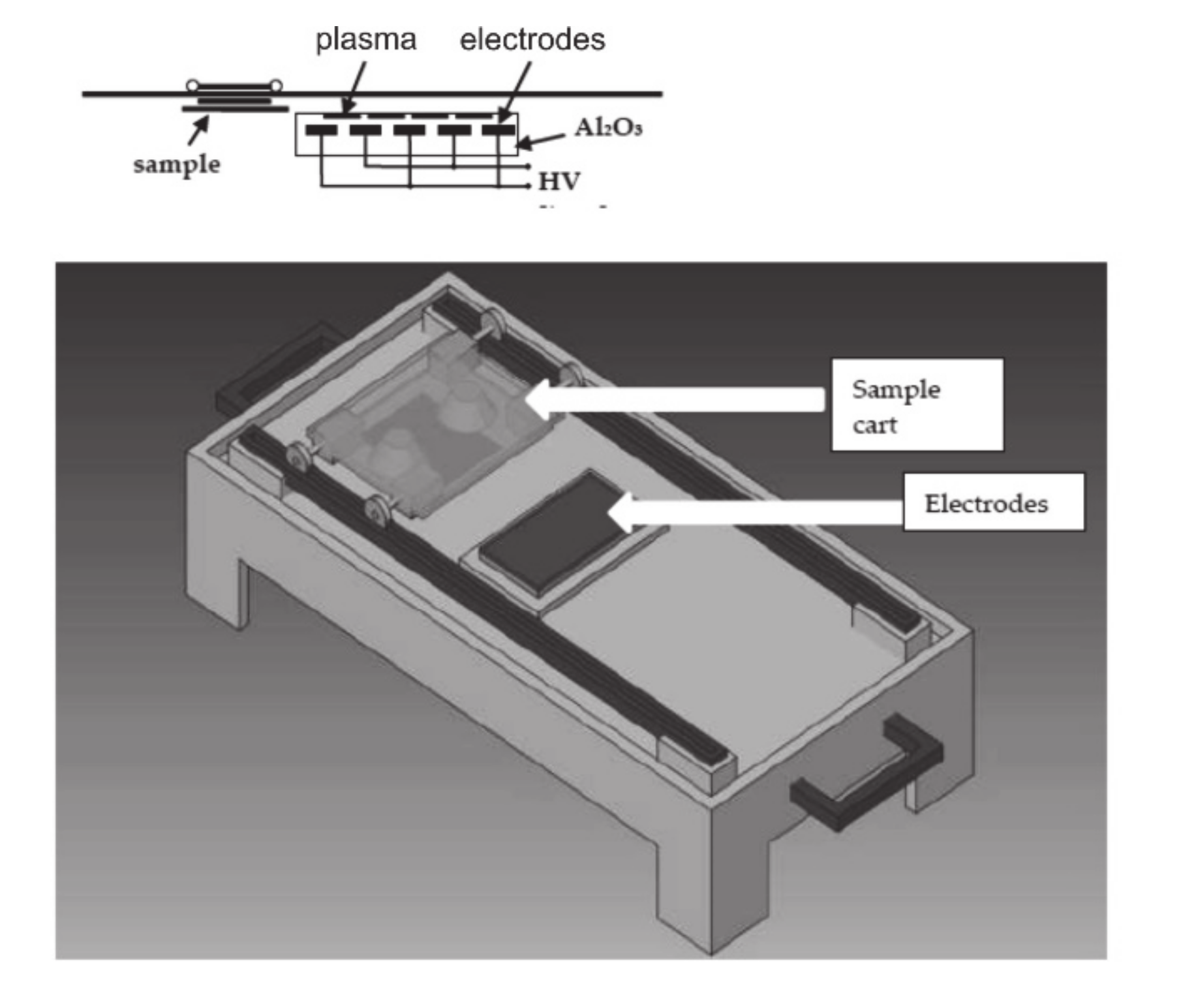

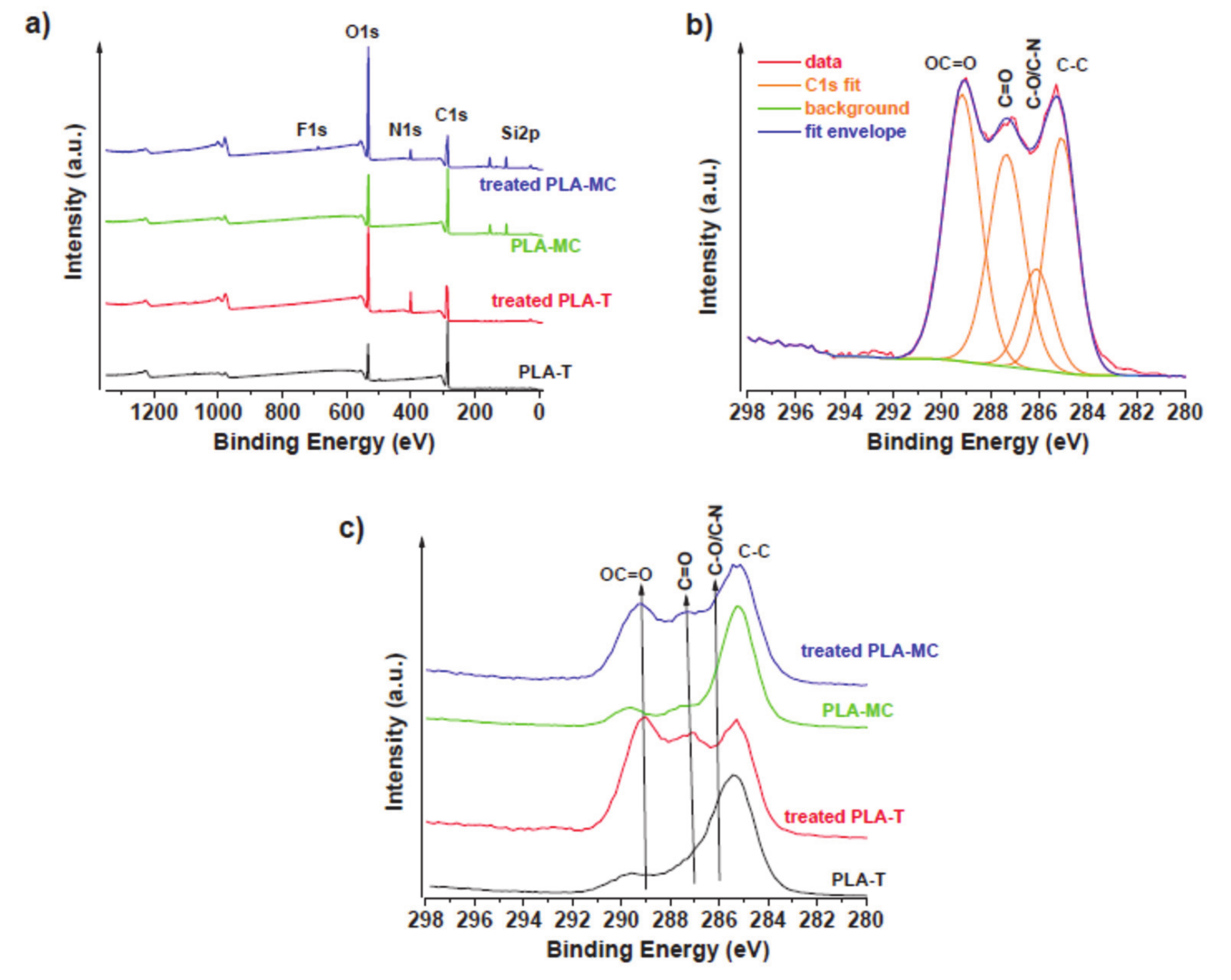
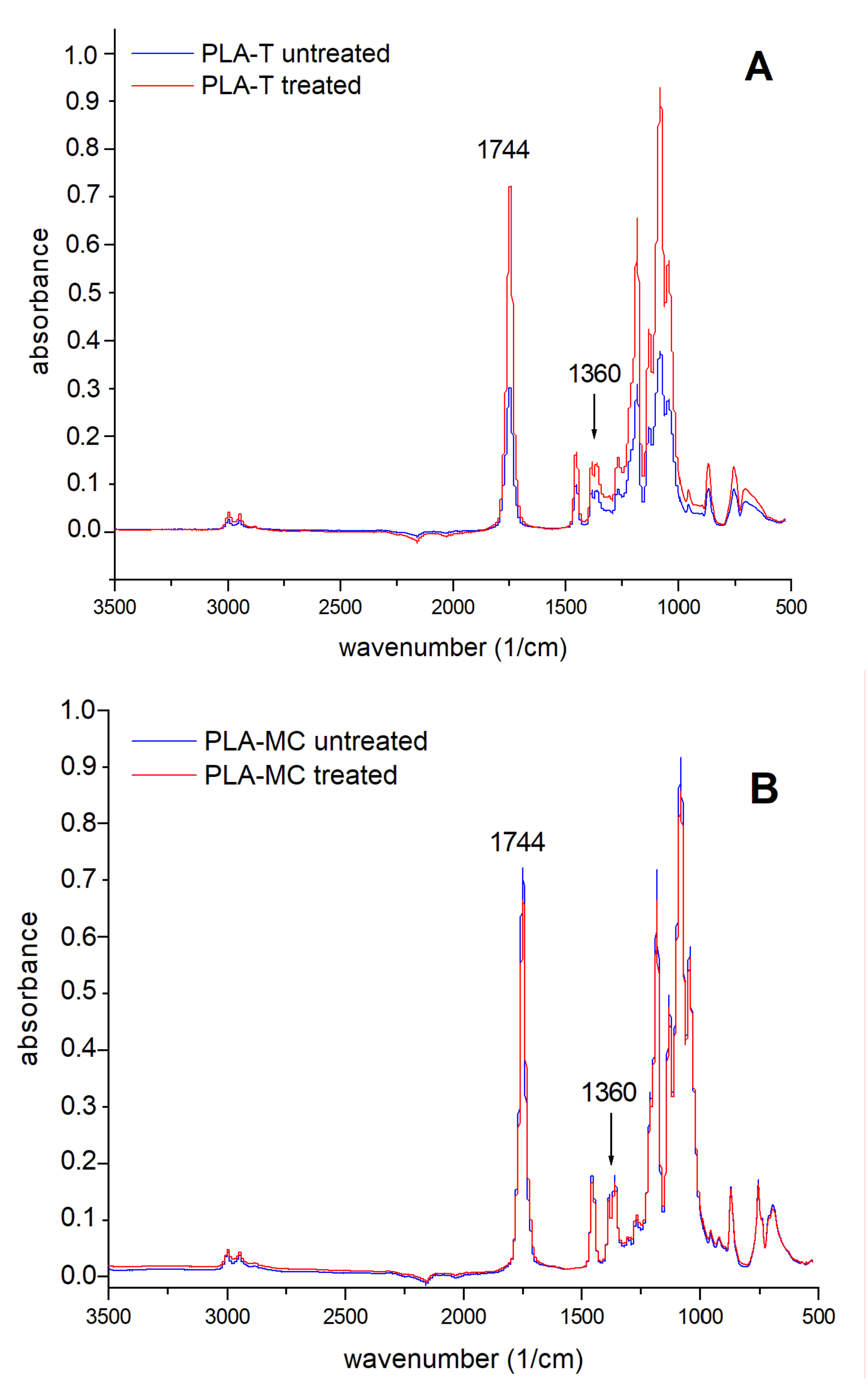
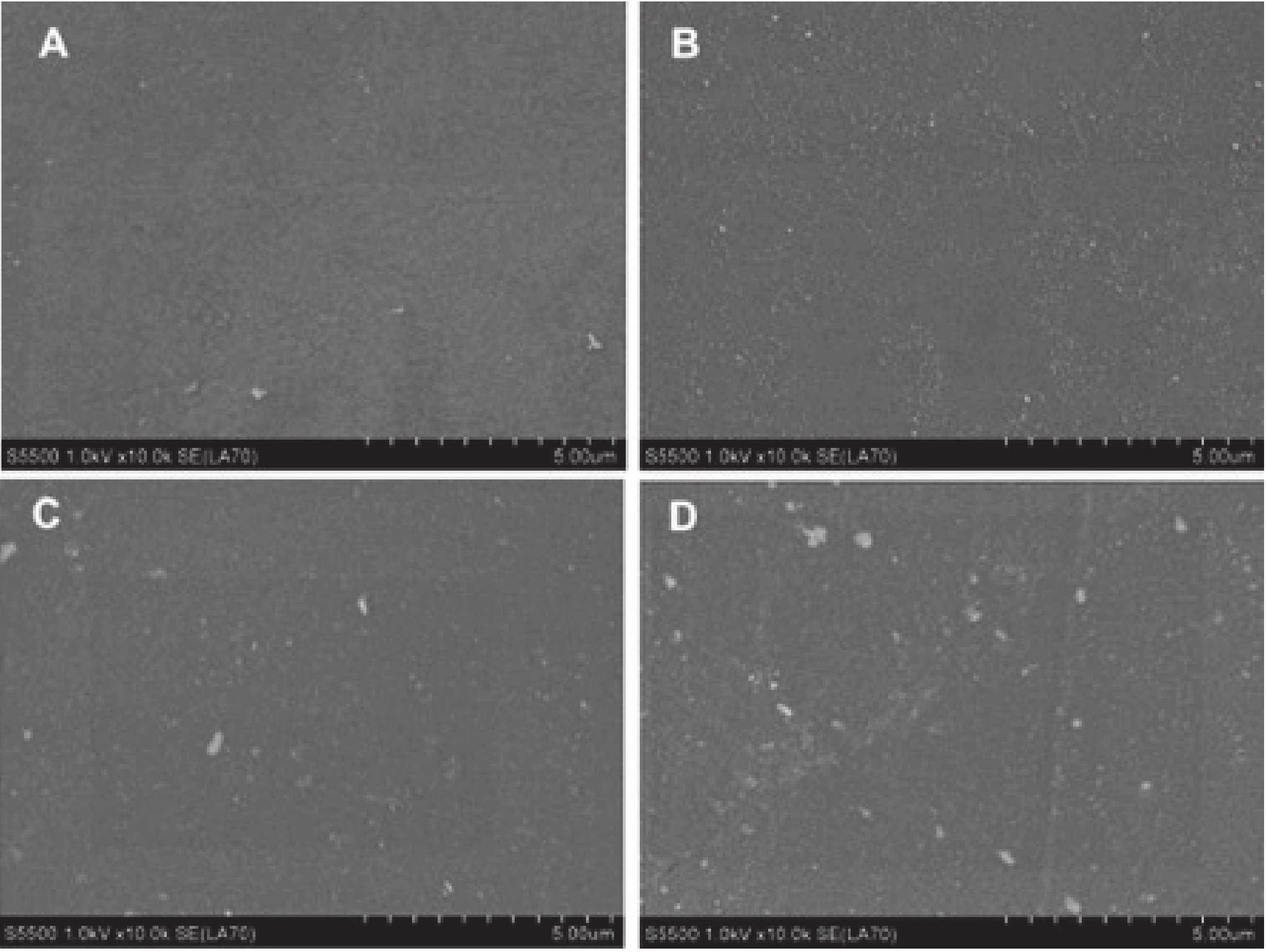

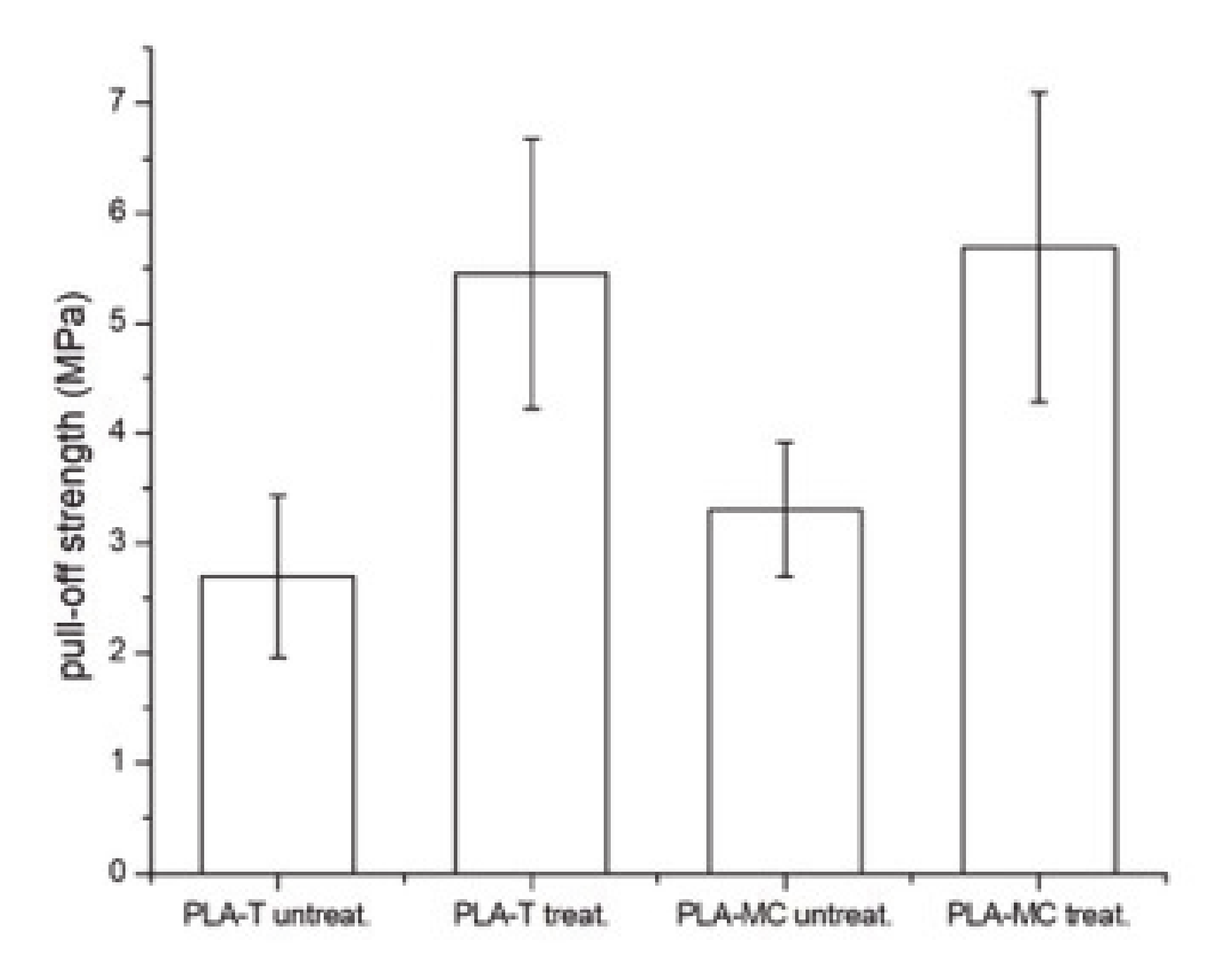
| Sample | Surface Chemical Composition (Atomic %) | ||
| C1s C-C/C-O/C = O/OC = O | O1s | Si2p/P2p/S2p/N1s/F1s/Na1s/Cl2p | |
| Untreated PLA-T | 79.4 30.4/29.2/11.7/8.0 | 18.3 | 0.8/0.3/0.2/0.7/-/0.3 |
| Treated PLA-T | 53.5 14.4/6.2/14.6/18.4 | 35.2 | 0.2/0.3/0.2/10.1/-/0.2/0.3 |
| Untreated PLA-MC | 67.0 48.0/5.1/6.5/7.4 | 23.3 | 9.0/0.4/-/-/0.3/-/- |
| Treated PLA-MC | 43.8 14.1/7.3/10.2/12.2 | 40.3 | 9.0/0.5/0.1/5.4/0.9/-/- |
| Series | Contact Angle (°) | SFE (mJ/m2) | Rt (MPa) | |
|---|---|---|---|---|
| Water | Diiodomethane | |||
| PLA-T untreated | 66.3 ± 1.4 | 42.6 ± 0.7 | 47.9 | 3.4 ± 0.4 |
| PLA-T treated | 49.7 ± 2.3 | 27.9 ± 1.5 | 61.0 | 8.2 ± 0.7 |
| PLA-MC untreated | 61.4 ± 1.5 | 66.5 ± 1.7 | 45.8 | 4.8 ± 0.5 |
| PLA-MC treated | 57.4 ± 0.8 | 35.8 ± 0.7 | 61.2 | 7.7 ± 0.6 |
Publisher’s Note: MDPI stays neutral with regard to jurisdictional claims in published maps and institutional affiliations. |
© 2021 by the authors. Licensee MDPI, Basel, Switzerland. This article is an open access article distributed under the terms and conditions of the Creative Commons Attribution (CC BY) license (https://creativecommons.org/licenses/by/4.0/).
Share and Cite
Mamiński, M.Ł.; Novák, I.; Mičušík, M.; Małolepszy, A.; Toczyłowska-Mamińska, R. Discharge Plasma Treatment as an Efficient Tool for Improved Poly(lactide) Adhesive–Wood Interactions. Materials 2021, 14, 3672. https://doi.org/10.3390/ma14133672
Mamiński MŁ, Novák I, Mičušík M, Małolepszy A, Toczyłowska-Mamińska R. Discharge Plasma Treatment as an Efficient Tool for Improved Poly(lactide) Adhesive–Wood Interactions. Materials. 2021; 14(13):3672. https://doi.org/10.3390/ma14133672
Chicago/Turabian StyleMamiński, Mariusz Ł., Igor Novák, Matej Mičušík, Artur Małolepszy, and Renata Toczyłowska-Mamińska. 2021. "Discharge Plasma Treatment as an Efficient Tool for Improved Poly(lactide) Adhesive–Wood Interactions" Materials 14, no. 13: 3672. https://doi.org/10.3390/ma14133672
APA StyleMamiński, M. Ł., Novák, I., Mičušík, M., Małolepszy, A., & Toczyłowska-Mamińska, R. (2021). Discharge Plasma Treatment as an Efficient Tool for Improved Poly(lactide) Adhesive–Wood Interactions. Materials, 14(13), 3672. https://doi.org/10.3390/ma14133672








